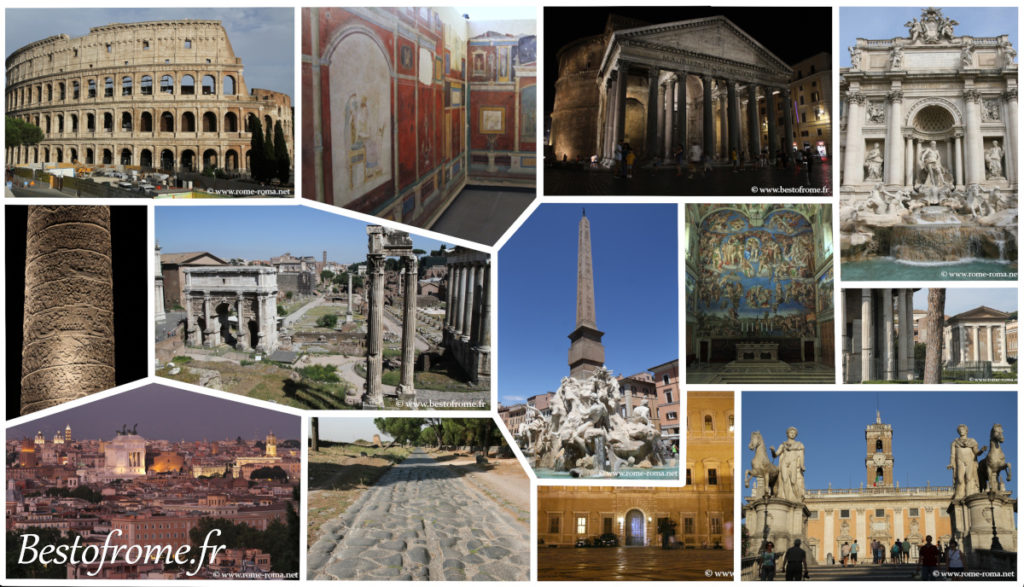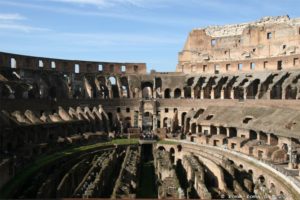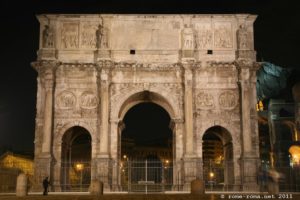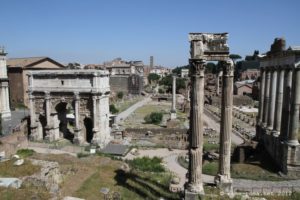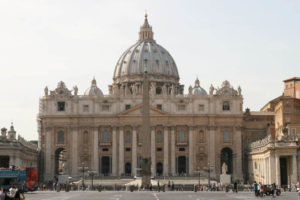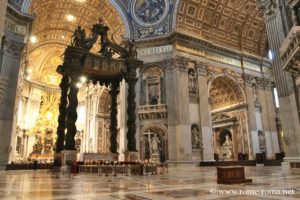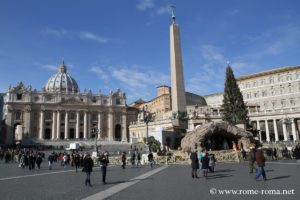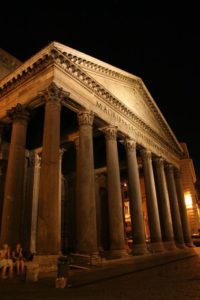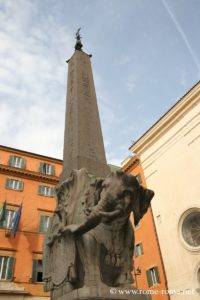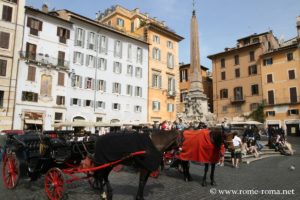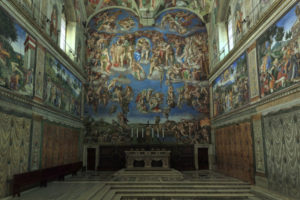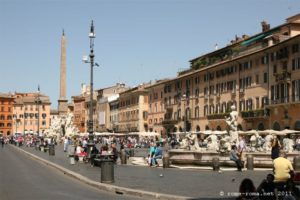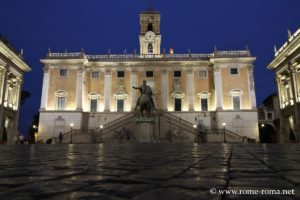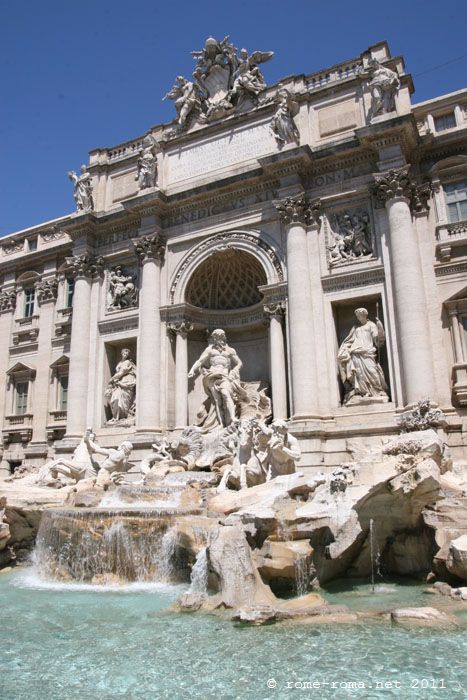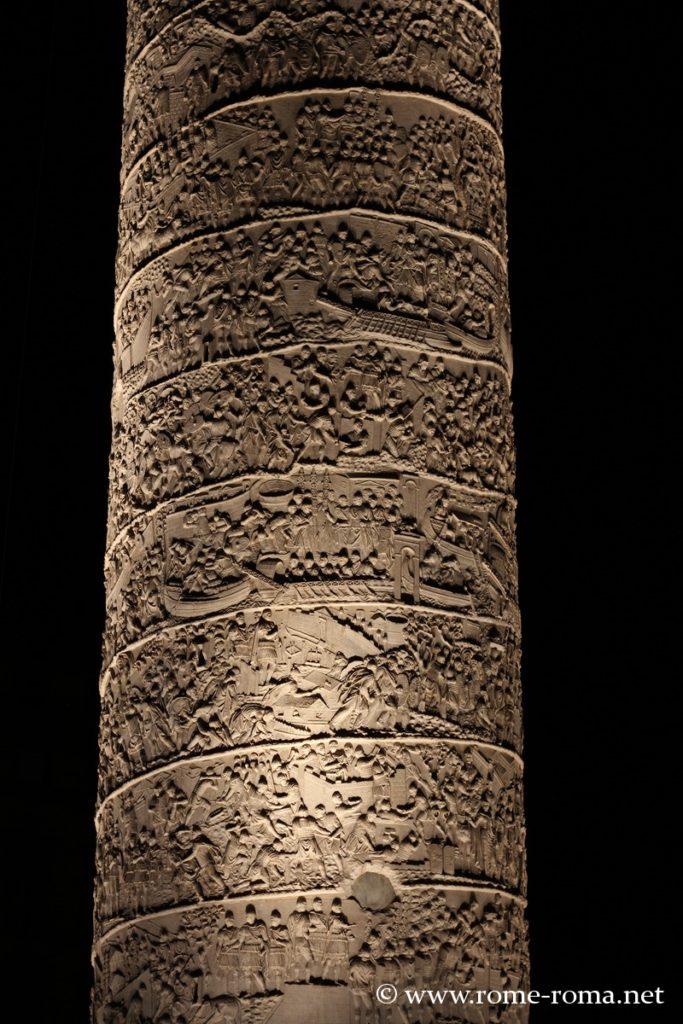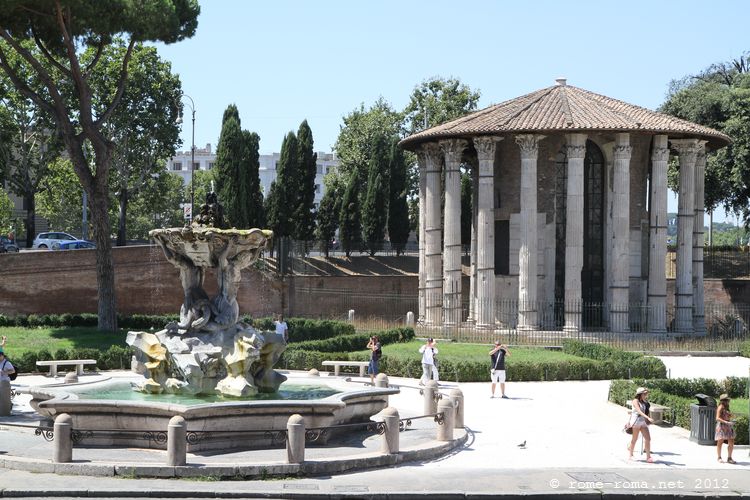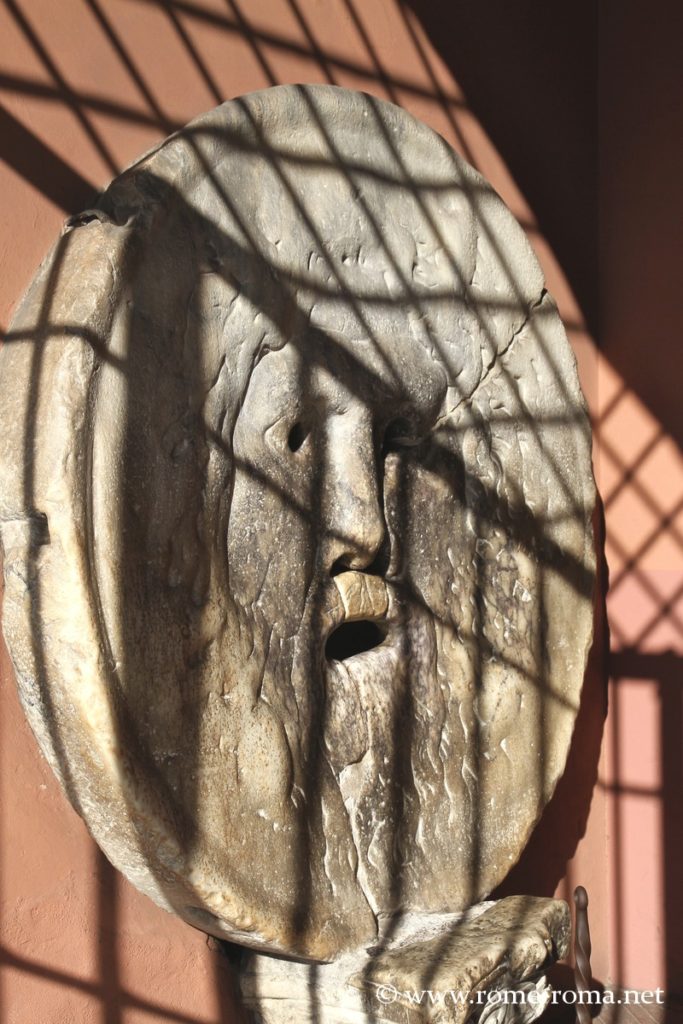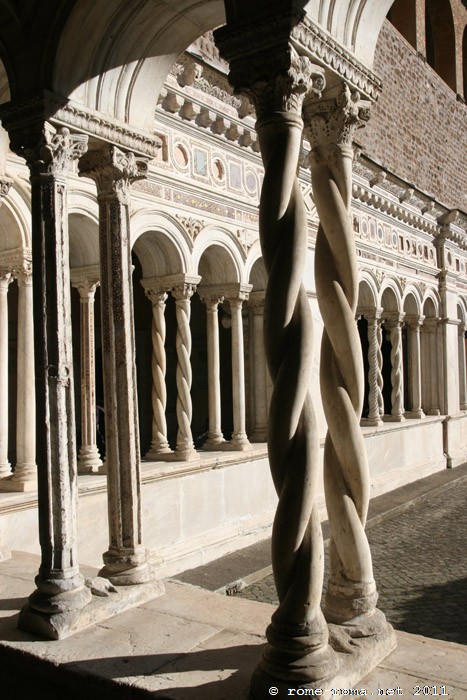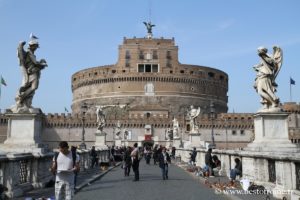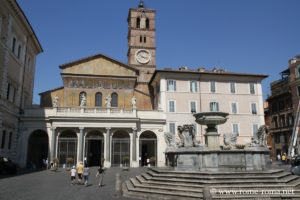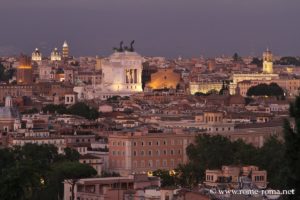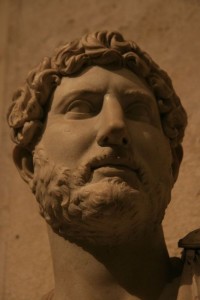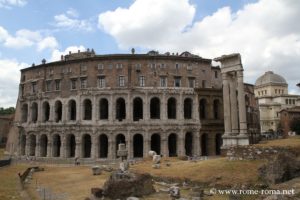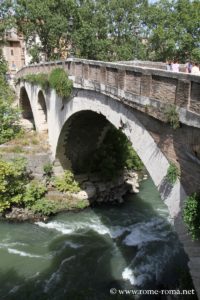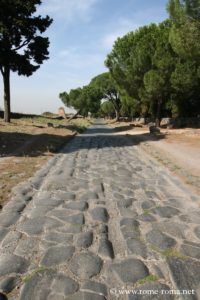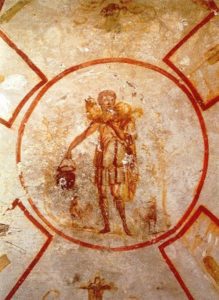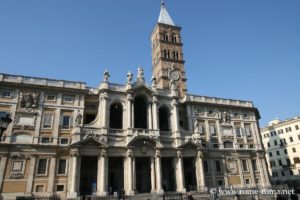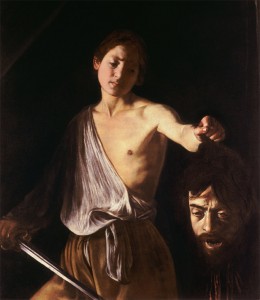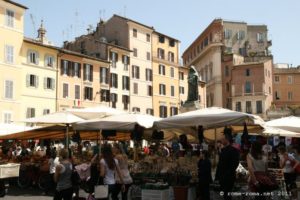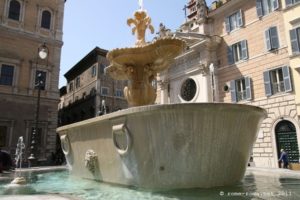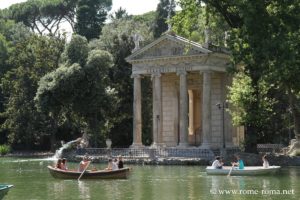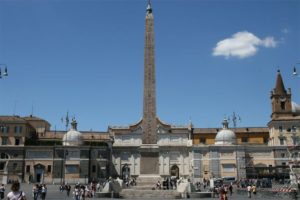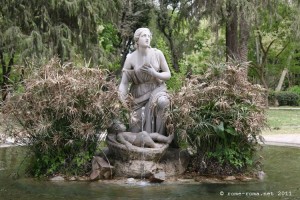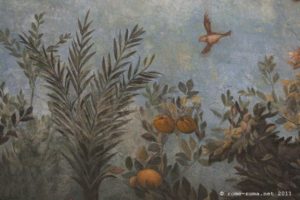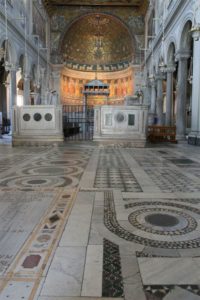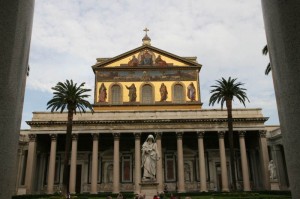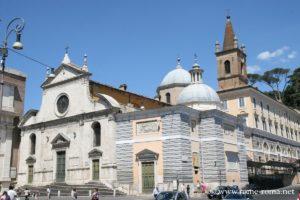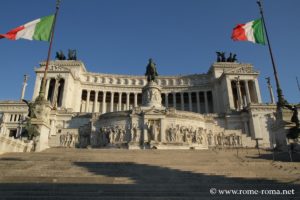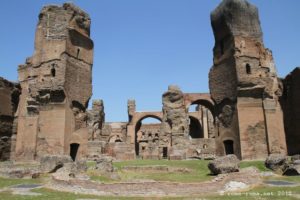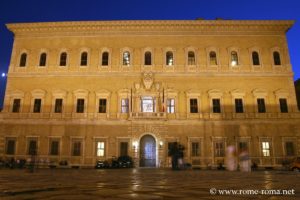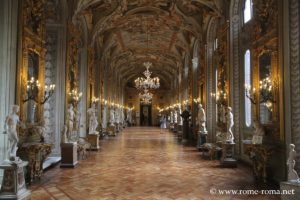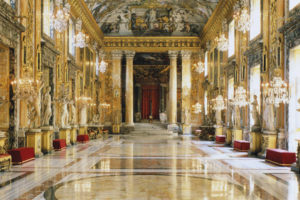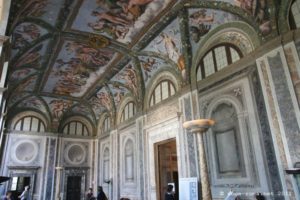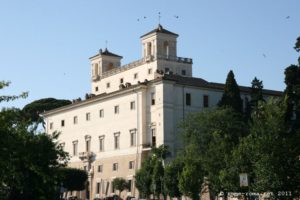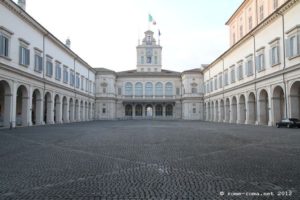When visiting Rome for the first time, how can you avoid the Colosseum or St Peter’s Square with the extraordinary basilica? Then there are so many beautiful sites and monuments, that making a ranking and a selection becomes quite subjective. So take this list taking into account your interests more than the “ranking”
1. Colosseum, Roman Forum, and Palatine (in Top 30)
This ancient complex, accessible with a single entrance ticket, includes the most impressive ancient remains in Rome, testifying to the power of the Roman Empire that stretched over three continents.
The Colosseum is unmissable in Rome, emblem of the city and its ancient prestige. Although he lost more than half of his stones, he still impresses, even the regulars. It is the largest Roman amphitheatre, with its elliptical shape, where gladiator and animal fights were held to entertain the aristocracy as well as the small people. A good part is well preserved, including the interior accesses. Next to it is the beautiful Arch of Constantine.
In a valley almost 600 meters long, the Roman Forum is one of the most remarkable archaeological spaces of ancient Rome, political and cultural center of the Republic and the Roman Empire. There are fascinating and numerous remains of temples, shrines and public buildings.
It is dominated by the Palatine Hill with the ruins of the sumptuous imperial cities.
→ See also best guided tours in Colosseum and Roman Forum from our partner
2. St Peter’s Basilica and St Peter’s Square (in Top 30)
The Saint Peter’s Basilica with the Colosseum the other emblem of Rome, let’s say the Christian side. This extraordinary religious building is the largest of Catholicism, built on the tomb of Peter. It was rebuilt from the sixteenth century, magnified by the Renaissance and Baroque styles. Michelangelo drew his huge dome reaching 119 meters in height, and the interior keeps precious works.
Saint Peter’s Square was converted with the reconstruction of the basilica. It is an impressive space that welcomes the pilgrim and the traveller between the superb colonnades designed by Bernini, forming like two arms attached to the basilica that embrace the visitor.
→ See also the best guided tours in Saint Peter
3. Pantheon, Piazza Rotonda and Piazza Minerva (in Top 30)
The Pantheon is an exceptional legacy of antiquity. It was a temple to pay tribute to the great Greco-Roman gods. Its conservation is remarkable, with its circular main body covered with an impressive dome pierced with an oculus and its pronaos. It houses the tombs of prestigious figures such as King Victor Emmanuel II or Raphael Sanzio.
This last monument is displayed on the charming Piazza della Rotonda with the beautiful baroque fountain and its small obelisk. On the side of the Pantheon is also the remarkable Piazza della Minerva, where the church hides a Gothic interior, but it is distinguished above all by the statue in the center, a unique sculpture with the superb elephant carved by Bernini who carries an obelisk on his back.
→ See also the best guided tours including the Pantheon
4. Vatican Museums (in Top 30)
The immense Vatican Museums embrace the whole of history related to Rome and the church, housed in the Apostolic Palaces of the Vatican. The masterpieces are innumerable, of incomparable richness and diversity in Italy, from antiquity to modernity. In addition, the famous Sistine Chapel marked by the huge frescoes of Michelangelo, the Raphael Rooms, the Borgia Apartment, etc.
→ See also the best guided tours in the Vatican Museums and Sistine Chapel
Among the beautiful squares of Rome, Piazza Navona (Navona Square) is the most emblematic of Rome, having kept the shape of the ancient Stadium of Domitian whose remains are located under the square. It is a lively and lively place, marked by the exuberance of its exceptional baroque architecture that culminates with the monumental Fountain of the Four Rivers designed by Bernini and surmounted by an Egyptian obelisk.
6. Piazza del Campidoglio (in Top 30)
The Capitoline Hill dominates the Roman Forums, with beautiful views and the harmonious Piazza del Campidoglio (Capitoline Square) designed by Michelangelo in the 16th century, with in the center the equestrian statue of Marcus Aurelius, surrounded by palaces and monuments – which house the Capitoline Museums – like the Cordonata staircase and the colossal statues of Castor and Pollux.
7. Spanish Steps (in Top 30)
The famous Spanish Steps are the most original of the Roman squares, with its elegant monumental baroque staircases, dominated by the twin bell towers of Trinità dei Monti church, and at its feet is the charming boat-shaped fountain designed by the father of Bernini. It is located in an area with the most chic shops in Rome. It is also a romantic place, with its flowery terraces in spring, close to the park of Villa Borghese and Pincio.
8. Trevi Fountain (in Top 30)
The Trevi Fountain is the most famous fountain in Rome. It is certainly the most theatrical, which is printed in the collective imagination since Fellini’s La Dolce Vita, although this image dissolves with time and the new generations tic-toc. It depicts aquatic scenes including a personification of the Ocean, in its late baroque style of the eighteenth century.
9. Imperial Forums (in Top 30)
Just across the avenue of the Fori Imperiali and opposite the Roman Forum, are the Imperial Forums, including the Trajan Forum with the extraordinary Trajan Column carved with episodes of the Emperor’s campaigns against the Dacians in present-day Romania, forming a frieze all around the column, and also the Forums of Caesar, Augustus, Vespasian, and Nerva.
10. Boarium Forum and Boccà della Verità Forum (in Top 30)
The Boarium Forum is located near the current Bocca della Verità Square. It was in antiquity the site of a port market of which two beautiful temples remain well preserved, the Temple of Portunus and Temple of Hercules, and the buildings of the neighboring Velabro as the Arch of Janus.
On the square the beautiful church of Santa Maria in Cosmedin has Romanesque and older elements like its large bell tower or the cosmatesque pavement. It houses under its porch the famous Mouth of Truth, a Roman manhole carved with a face.
11. Basilica of Saint John the Lateran (in Top 30)
The basilica Saint John Lateran is the cathedral of the Pope as bishop of Rome. It is the oldest church in the city, built by Constantine around 320 AD, considered the mother of all churches. It was rebuilt throughout history, but its baptistery retains early Christian elements. In the back square stands the Lateran Obelisk, the largest Egyptian obelisk in Rome, and opposite the Scala Santa.
Piazza della Boccà della Verita Bocca della Verità Cloister of Saint John Lateran
12. Castle Sant’Angelo and Ponte (in Top 30)
The Castel Sant’Angelo is one of the most beautiful and interesting Roman monuments. It stands on the right bank of the River Tiber. Its cylindrical central body is formed by the ancient Mausoleum of Hadrian which was fortified from the early Middle Ages. It is reached by crossing the Tiber by the Ponte Sant’Angelo bridge of Roman origin decorated with statues of the Passion designed by Bernini.
13. Trastevere and Janiculum (in Top 30)
Located on the right bank of the River Tiber, the charming district of Trastevere, with its pretty alleys or beautiful basilica, has become fashionable but retains some of its authenticity.
To the west rises the steep slopes of the Janicule hill with its beautiful view of the city and the dome of Saint-Pierre.
14. Capitol Museums (in Top 30)
On the square of the same name the important Capitoline Museums preserve many remarkable works and objects related to the Roman civilization, mainly sculptures, but also sarcophagi, mosaics, artifacts, and a section of paintings of the Renaissance and Baroque.
15. Marcellus Theatre, Ghetto and Tiberina Island (in Top 30)
The Roman ghetto is a charming neighborhood in the heart of the city marked by a secular Jewish presence, with pretty squares like Piazza Mattei with the Turtles Fountain. It is close to the Roman Theatre of Marcellus in stone, and other suggestive ancient sites like the remains of the Porticus Octaviae. Nearby you can reach the tranquillity of Tiberina Island by taking one of its two pretty old bridges.
16. Appian Way (in Top 30)
The Appian Way (Appia Antica) leaves Rome in the south-east from Porta San Sebastiano Gate, crossing for several kilometers a green setting and fields. Its journey is a fascinating immersion in the past, with the graves that surround it, ancient and medieval sites, including the catacombs, the Villa of Maxencius, the Mausoleum of Cecilia Metella. This Roman road keeps portions of the ancient pavement.
17. Catacombs (in Top 30)
Early Christian catacombs are numerous in Rome. They are fascinating places rich in history but also with ancient art forms. The main ones are those of San Callisto, Domitilla and San Sebastian located along the Via Appia, then those of Priscilla on the Via Salaria.
18. Saint Mary Major (in Top 30)
The vast basilica Saint Mary Major is of great architectural and artistic richness, marked by several eras of Christian art, since Paleochristian with its five majestic naves, its beautiful medieval Romanesque bell tower, the Renaissance interior alterations or the Baroque façade and domes.
19. Borghese Gallery (in Top 30)
In the pretty and quite large park of the Villa Borghese, the Borghese Gallery brings together three collections. The most famous are those of baroque sculptures and Renaissance paintings, including works by Caravaggio or neo-classical and antique sculptures like those by Bernini.
20. Campo dei Fiori and Piazza Farnese (in Top 30)
These are two charming squares very close and very different. The first, Campo dei Fiori, hosts a small market in the morning, and remains lively all day with its bars, restaurants, or passers-by who come to relax or meet at the foot of the suggestive statue of Giordano Bruno. It recalls that the Inquisition here condemned heretics to the stake. The second is the grandiose Piazza Farnese which owes its allure to the superb Palazzo Farnese, and its harmony to its two fountains bathtubs.
21. Villa Borghese (in Top 30)
Villa Borghese is the main public park in the centre of Rome, near the Spanish Steps, the Piazza del Popolo and the Pincian hill. It is landscaped with several monuments, statues, a small lake, green and wooded areas, and museums.
22. Piazza del Popolo and Pincio (in Top 30)
Piazza del Popolo square is majestic by its grandeur, highlighted with the large Egyptian obelisk erected in the center and its artistic fountains.
Above is the small Pincian hill with a beautiful view of the square, and its charming little park.
23. National Roman Museum (in Top 30)
The National Roman Museum houses the largest archaeological collection in the world, visible in several sites, especially at the main headquarters of the Palazzo Massimo where are preserved wonderful ancient sculptures and especially the frescoes of the rooms of Roman houses. Not far away the beautiful Baths of Diocletian shelter another part while towards the Piazza Navona is the Palazzo Altemps and its many ancient sculptures.
24. Basilica of Saint Clement (in Top 30)
The Basilica of Saint Clement is one of the most beautiful illustrations of the architectural history of two millennia in Rome, during which time the city rose several meters, the new constructions superimposing on the oldest or has their vestiges. Here, there are three levels, the lowest dating from the Roman Republic, surmounted by a remarkable early Christian church for its unique frescoes, and the current church under the street level with mosaics of the twelfth century.
25. Saint Paul Outside the Walls (in Top 30)
The majestic Basilica of Saint Paul outside the walls was completely rebuilt after the fire of 1823, with its five naves. A large frieze covers the top of the interior of the building which has 265 portraits of popes. It has preserved its elegant 13th century cloister and the mosaic of the Apocalypse in the apse dating back to the 5th century.
26. Basilica of Santa Maria del Popolo (in Top 30)
The Parish Basilica of Santa Maria del Popolo is certainly one of the most important testimonies of the Roman Renaissance. It is a true museum of this period, on the one hand because of its architectural characteristics, and on the other hand for its many masterpieces like paintings and sculptures, such as the Chigi Chapel designed by Raphael and Bernini, the paintings of Caravaggio, the frescoes of the Pinturicchio, etc.
27. Victor Emmanuel II Monument and Piazza Venezia (in Top 30)
Piazza Venezia, the central square of Rome, is dominated by the large white marble monument dedicated to Victor Emmanuel II, known as Vittoriano, whose terraces can be climbed and discover the many neoclassical sculptures.
28. Baths of Caracalla and Caelius (in Top 30)
The Baths of Caracalla were one of the most grandiose Roman thermal complexes. A good part of the structure of these imperial baths is preserved, although there are few ornaments such as frescoes or mosaics.
On the nearby hill of Caelius, there are interesting churches (Saints John and Paul, Saint Stephen in the Round), as well as ancient remains such as a street, Roman houses, and the small park of the Villa Celimontana.
29. The most beautiful Roman palaces (in Top 30)
The Farnese Palace is the seat of the French Embassy in Italy and one of the most remarkable and emblematic palaces in Rome, built in the Renaissance in the 16th century, with the participation of Michelangelo and Dalla Porta, including salons with prestigious frescoes.
The Pamphilj Palace, dating from the 16th-18th centuries, is one of the most beautiful and extensive in Rome, in late Baroque style, with a sumptuous hall of mirrors, and also houses the Doria-Pamphilj Gallery, a prestigious private museum.
The vast Colonna Palace also houses an important private museum. It was formed over nearly five centuries since the 14th century, with various styles, including a superb gallery, becoming a famous aristocratic baroque residence embellished by masters such as Bernini or Carlo Fontana.
Villa Farnesina is a villa from the early sixteenth century, located on the Trastevere side. It is an emblematic Renaissance residence, famous for its extraordinary frescoes depicting ancient myths, painted above all by Raphael and his school.
Villa Medici is located on the Pincian hill near the Spanish Steps. It houses the French Academy in Rome. It is a remarkable Renaissance ensemble of the sixteenth century, with an opulent rear facade, an Italian garden and a large park of 7 hectares.
At the top of the Quirinal hill, the Quirinal Palace hosts the Presidency of the Italian Republic. Sixth largest palace in the world with 110,000 m², it is one of the most important monuments of Rome both from an artistic, historical and political point of view. To its construction started from the late sixteenth century, contributed masters such as Domenico Fontana, Bernini, or Carlo Maderno.
30. Aventine hill and Circus Maximus (in Top 30)
On the peaceful and residential Aventine hill, is the beautiful and very old Basilica of Saint Sabina, as well as the charming little orange garden with its terrace a beautiful panoramic view.
At its feet in the valley between the Aventine and the Palatine lie the remains of the Circus Maximus, whose proportions are preserved and which today host great festivals and events.






